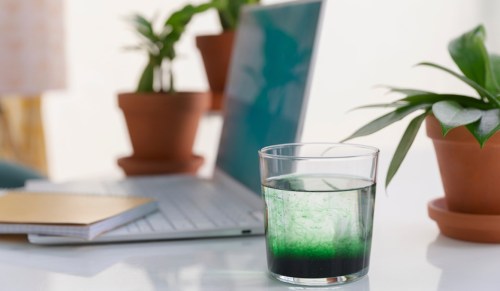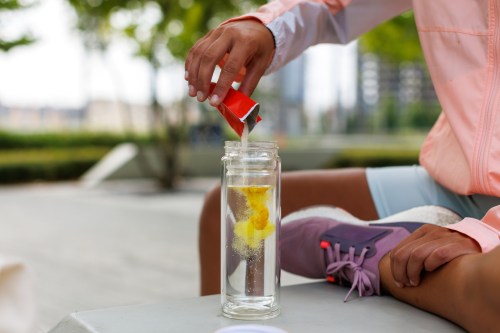Why Nutrition Experts Think That Liquid Chlorophyll Craze Is a Bit Bogus—and What To Eat To Get Your Superfood Fix Instead
A dietitian explains why consuming foods with chlorophyll means more chlorophyll benefits than drinking liquid chlorophyll water.

TikTok is a treasure trove of wellness hacks. Gynecologist-backed tips on washing your vulva? Good to know. Sheet pan baked feta pasta? Downright genius. But you can, of course, venture too far down the rabbit hole, indulging in wellness practices that may not be necessary at all.
Experts in This Article
registered dietitian nutritionist and owner of The Nutrition Tea
clinical nutritionist, chiropractor, and founder of Root Cause Medical Clinics
Case in point: chlorophyll water. The emerald green drink is making its rounds on social media as the latest “it” wellness drink. The below TikTok—one of many centering around chlorophyll water—has racked up over 1.6 million views.
If you’ve seen the trend but still aren’t clear on what exactly chlorophyll is, it’s the green-colored pigment found in fruits, vegetables, and other plants. While chlorophyll is a goldmine of nutrients, according to Vikki Petersen, DC, CNN, CFMP, a certified functional medicine practitioner, chiropractor, and certified clinical nutritionist, chugging chlorophyll water isn’t the only way to get them. In fact, it is not even the best way. Intrigued? Keep reading for everything you need to know.
What are the key chlorophyll benefits, exactly?
As mentioned, chlorophyll is what gives certain plants their green hue. “Chlorophyll helps plants absorb energy from the sun during photosynthesis,” Dr. Petersen says, recapping what you probably haven’t thought about since fifth grade science class. She explains that liquid chlorophyll—the type popping up in tincture form on TikTok—is an extraction of the chlorophyll found in dark green plants.
Chlorophyll does, in fact, have benefits. It has vitamins A, C, E, and K, and it packs a powerful antioxidant-rich punch. It has also been linked to being good for the gut. “Chlorophyll helps with digestion by increasing the beneficial bacteria in the digestive tract. It’s also antimicrobial, so it helps get rid of harmful bacteria while maintaining healthy ones,” registered dietitian Lisa Samuels, RD, previously told Well+Good.
Dr. Petersen says there are some beauty benefits to chlorophyll as well—specifically that if it’s used topically, it could help with would healing (another benefit of being antimicrobial), acne, and anti-aging from sun exposure (but please know you that it is not an excuse to skip the sunscreen).
With a health resume like this, you can see why the nutrient became the star of the TikTok world. But the benefits are only half of what’s important to know about chlorophyll. The best ways to consume it are just as important—and might also surprise you.
What are the best foods with chlorophyll?
“There is no overwhelming research to support the use of ingesting isolated chlorophyll in either liquid or tablet form,” Dr. Petersen says. That’s an important piece of information considering just how viral chlorophyll supplements and tinctures have become on social media—and how expensive it can be to incorporate as a daily wellness habit.
If there’s not enough evidence to support consuming chlorophyll in liquid or tablet form, how should you consume it? Through regular ‘ol food, of course. Dr. Petersen says that dark leafy greens, broccoli, and wheatgrass are all great sources of chlorophyll. “Eating actual vegetables with all the combined components of fiber, phytonutrients, and antioxidants, far outweighs a chlorophyll tablet or powder,” she says.
Eating chlorophyll-containing foods instead of the extract means you’re not only going with the form of it that’s more backed by science, it also means you’re reaping many more benefits than just the chlorophyll on its own. (Don’t even get dietitians started on the importance of fiber…) “There really isn’t a need to drink this as a supplement,” agrees nutrition expert Shana Spence, RD. In her opinion, drinking chlorophyll water doesn’t cause harm exactly; she just doesn’t see the real benefit of it.
While chlorophyll does have many benefits, Dr. Petersen says there is no official ruling on how much you actually need. “There is not a specific daily allowance for chlorophyll, although some sites mention about 100 to 300 milligrams per day,” she says. “If you consider that a serving of spinach has about 25 milligrams, about four servings per day will achieve that.”
What Dr. Petersen says is that it is more important to be mindful of is your leafy green intake. “Not eating enough chlorophyll is equivalent to not eating enough dark green vegetables, which put you at risk for inflammation, a weaker immune system, fatigue, and more,” she says. She recommends eating seven to nine servings of vegetables and fruit a day (leaning more on the veggie side than the fruit side) to help cover those bases.
It bears repeating that chlorophyll is nutrient-rich. It’s just not as beneficial on its own as when consuming the entire plant it comes from—whichever green-colored food you fancy. It’s also cheaper this way, too.
Sorry TikTok, this is one wellness trend that’s more hype than it’s worth.
Oh hi! You look like someone who loves free workouts, discounts for cult-fave wellness brands, and exclusive Well+Good content. Sign up for Well+, our online community of wellness insiders, and unlock your rewards instantly.










